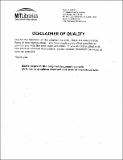| dc.contributor.advisor | Eugene A. Fitzgerald. | en_US |
| dc.contributor.author | McGrath, John F. (John Francis), 1976- | en_US |
| dc.contributor.other | Leaders for Manufacturing Program. | en_US |
| dc.date.accessioned | 2006-11-08T16:29:44Z | |
| dc.date.available | 2006-11-08T16:29:44Z | |
| dc.date.copyright | 2004 | en_US |
| dc.date.issued | 2004 | en_US |
| dc.identifier.uri | http://hdl.handle.net/1721.1/34739 | |
| dc.description | Thesis (S.M.)--Massachusetts Institute of Technology, Dept. of Materials Science and Engineering; and, (S.M.)--Massachusetts Institute of Technology, Sloan School of Management; in conjunction with the Leaders for Manufacturing Program at MIT, 2004. | en_US |
| dc.description | Includes bibliographical references (p. 80). | en_US |
| dc.description.abstract | Lattice mismatched semiconductor substrates provide a platform for higher performance semiconductor devices. Through epitaxial growth on GaAs, the lattice constant of the film can be expanded resulting in a desired InxGalxAs film on which devices can be fabricated. The resulting device exhibits enhanced performance characteristics not achievable on the initial substrate. A self-aligned mesa structure process was developed to fabricate a prototype HBT device utilizing an InxGalxAs lattice mismatched semiconductor substrate. The self-aligned mesa process eliminated the need for complicated metal etch steps by using a lift-off process and deposited contact metal as an etch mask. Selecting etches that highlight the selectivity of the device layers was critical to the success of the process. In addition to developing a process to fabricate a device, a market analysis is performed of the possible application space of the technology and derived products. In assessing the feasibility of the possible products, two main areas were addressed, the markets and the competition within each market. The technology innovation has the ability to attract a variety of markets already served by compound semiconductors. The possible markets and the competition, companies and other materials, already serving the markets are identified and characterized. To determine what markets would be attractive, the full landscape of semiconductor applications is developed. After which we were able to list the specifications and customer needs of each application as well as what materials and what companies were serving these markets. The expected performance for the innovation was then benchmarked against what we projected for the current providers in each application space. | en_US |
| dc.description.abstract | (cont.) Through the benchmarking process we were able to highlight markets in which we had a clear performance and cost advantage. | en_US |
| dc.description.statementofresponsibility | by John Francis McGrath. | en_US |
| dc.format.extent | 80 p. | en_US |
| dc.format.extent | 3612705 bytes | |
| dc.format.extent | 3612514 bytes | |
| dc.format.mimetype | application/pdf | |
| dc.format.mimetype | application/pdf | |
| dc.language.iso | eng | en_US |
| dc.publisher | Massachusetts Institute of Technology | en_US |
| dc.rights | M.I.T. theses are protected by copyright. They may be viewed from this source for any purpose, but reproduction or distribution in any format is prohibited without written permission. See provided URL for inquiries about permission. | en_US |
| dc.rights.uri | http://dspace.mit.edu/handle/1721.1/7582 | |
| dc.subject | Materials Science and Engineering. | en_US |
| dc.subject | Sloan School of Management. | en_US |
| dc.subject | Leaders for Manufacturing Program. | en_US |
| dc.title | The fabrication and market analysis of lattice mismatched devices | en_US |
| dc.type | Thesis | en_US |
| dc.description.degree | S.M. | en_US |
| dc.contributor.department | Leaders for Manufacturing Program at MIT | en_US |
| dc.contributor.department | Massachusetts Institute of Technology. Department of Materials Science and Engineering | |
| dc.contributor.department | Sloan School of Management | |
| dc.identifier.oclc | 56029798 | en_US |
